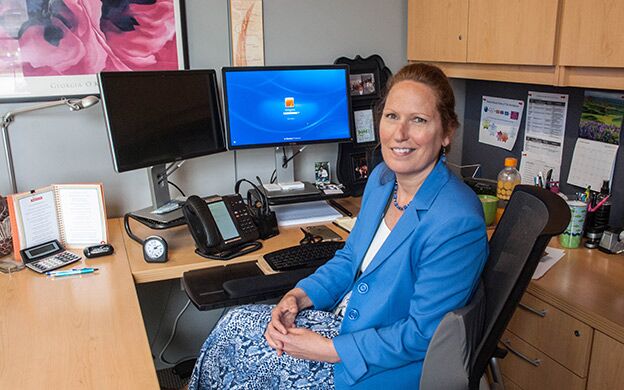Day 2: Helping people improve their health
 Photo / James McCarthy
Maggie Kelley, assistant vice president, medical services for Community Health Options, oversees programs like the insurer's partnership with the Maine Area Agencies on Aging that provide counseling to people with complex, chronic health conditions and suspected or identified socio-economic barriers to improving their health. The partnership's goal is to improve health outcomes for CHO's insured members and included a review of the participants' nutrition, social supports, in-home care needs, medications, cognitive functioning and environmental factors impacting health.
Photo / James McCarthy
Maggie Kelley, assistant vice president, medical services for Community Health Options, oversees programs like the insurer's partnership with the Maine Area Agencies on Aging that provide counseling to people with complex, chronic health conditions and suspected or identified socio-economic barriers to improving their health. The partnership's goal is to improve health outcomes for CHO's insured members and included a review of the participants' nutrition, social supports, in-home care needs, medications, cognitive functioning and environmental factors impacting health.
The Affordable Care Act called for the establishment of nonprofit “Consumer Operated and Oriented Plans,” or CO-OPs, with the idea that they would be innovators that would lower health care costs and find new ways of achieving the overriding goal of helping people become and stay healthy.
As nonprofits, CO-OPs were intended to offer health insurance at lower prices while also keeping their insured members’ interests foremost — a goal facilitated by the fact that they are governed by their members.
Of course, even with such lofty goals, CO-OPs are not immune to the challenges faced by for-profit insurers and all other segments of the health care industry. Community Health Options was one of 23 CO-OPs created under the ACA. Only five are still in business.
In today’s segment of our five-day series of interviews with Kevin Lewis, CEO of the Lewiston-based insurer Community Health Options, Mainebiz asked him to explain how his company has been working to align the health and wellness of its insured members with its own need to remain financially viable as a company. The following is from an edited transcript.
Mainebiz: We’ve talked a lot about numbers. Let’s talk about people and your goal of helping people stay well, or get better. What are some of the innovations you’ve tried to implement in the marketplace?
Kevin Lewis: Our benefits design is focused upon aligning incentives so that financial barriers don’t stand in the way of our members getting what they need to stay healthy.
MB: For example?
KL: The Chronic Illness Support Program. It’s a good example of where we have reduced financial barriers so that people with some prevalent chronic diseases can have access to care and many medications and treatment known to help people avoid poor health outcomes and associated higher costs of care.
MB: Asthma would be one?
KL: Yes, and also diabetes, chronic obstructive pulmonary disease, hypertension and coronary artery disease.
Now, for 2017 we had to tailor the program and align the chronic illness support program with our mail order fulfillment program, which helps in terms of cost as well as, frankly, adherence. We’re able to mail that prescription when it’s needed without that person having a break in available doses for chronic conditions that are particularly sensitive to pharmaco-adherence.
While this has been an adjustment that we know is not to everyone’s liking, we also need to pay attention to the total cost, not just for those members benefiting from this program but for the entire membership.
MB: In other words, people who sign on to this program, are they, in effect, signing on to a mailed prescription program … as opposed to going to their corner pharmacy?
KL: They can always fill their prescription at the corner pharmacy and those benefits will be covered like any other prescription benefit within the tier structure of our formulary.
MB: But they would be encouraged to consider the mailed prescription program?
KL: For now, if they want the additional financial benefits of the chronic illness support program, for those particular free or reduced cost chronic care medications, they have to fulfill their prescriptions by mail order.
MB: So that illustrates the challenges of working with members and trying to educate them on how innovations — mail-order prescriptions being one — might benefit them. But because it’s so new, is the challenge persuading them that it’s going to be beneficial?
KL: Yes. I think change has to be explained and made relevant to anyone affected. But part of our values is being able to cover a course of treatment or a given coverage level for therapy or prescription drugs at lower cost to the membership.
Another distinction I think is important to make is helping our members think differently about their own health care. This is an opportunity to help our members become more informed consumers about health care.
It’s not like it might have been 20 years ago. Today, it’s a matter of considering questions like, ‘Where do I go if I can get the most cost-effective treatment and improve my health and save money at the same time. In addition to plan design, we’ve also been working hard to help our members be more savvy consumers and ‘own’ their health care and their health.
Partnering with networks and providers
MB: How have you partnered with networks and providers to improve health of your members and reduce overall costs?
KL: There are a couple of examples. But I will say, these things are happening every day in the work of our care management team. We’ve partnered with Maine Medical Center and others to reduce hospital readmissions by addressing gaps in care and post-discharge planning. And while that’s really important to the good stewardship of plan resources, first and foremost this work improves health outcomes of our members.
It also aligns with the community goals of the hospitals involved. Many hospitals are stretched thin and struggle with capacity challenges — so freeing up resources to accommodate new admissions is equally important to them. Moreover, Medicare won’t pay for certain readmissions, and so by working in concert with their focus to reduce readmissions, it’s providing a consistent approach to a preventable problem.
This produces a real win-win-win for the member, the hospitals and Community Health Options.
MB: How does that program to reduce admissions work?
KL: It starts when our member — the patient — is still in the hospital. And it involves everything from discharge planning and the care that is established outside of the hospital after the member is discharged, to ensuring there is follow up care once at home. This is all intended to identify any points of failure, and making sure the person is able and equipped with the right resources to manage their ongoing health needs outside of the hospital.
Here’s another example: We’ve partnered with the Area Agencies on Aging. They cover the whole state and there are five of them, and we work with each individual location. We contracted with them the same way we contracted with the community care teams. The AAAs are ‘boots on the ground,’ and can conduct environmental assessments. For members in need, they can conduct medication reconciliations within the home, which is the gold standard. They look at all the medications the patient is taking and identify gaps or safety concerns.
For instance, one member who was a frequent utilizer at an emergency department was referred to the Area Agency on Agency. They were able to remove barriers and provide support. Since then the member has had fewer visits to the emergency department, which demonstrates a very effective partnership.
MB: That kind of partnership, it seems to me, doesn’t happen without trust.
KL: Correct.
MB: How do you achieve that trust?
KL: That’s a good question. It starts here with our culture, the currency of how we work with each other. The foundational element is trust. So if there is not trust in one another here, then we can’t really move very far beyond that.
I think it’s really relationship-based, understanding each other’s motives and that we’re inspired by the fact that we have a common goal, which is a better health status for our common clientele.
Value-based insurance design
MB: Do these examples illustrate that concept of ‘value-based’ insurance?
KL: Our chronic illness support program is a key component of that value-based insurance design. It focuses more of the benefits side of the equation. Another specific effort of ours focuses on reducing the incidence of hospital emergency department utilization for non-emergent needs. Ultimately, the member needs to be connected with a primary care medical home and ensuring that the right care is available at the right time in the right place.
Michael Gendreau, CHO's director of outreach, education and communications: We have a program with St. Mary’s Hospital that’s very similar to what we’ve been talking about. What they were doing is this: Every two weeks the care managers at St. Mary’s were sending a file over to our care management team. And our care management team was able to do a deeper dive and analyze the care that was given to each member and then we were able to reach out to the member and wrap the services around them so that they can stay at home and stay well.
That would not have happened without that ongoing sharing of information. And, again, it goes to that foundational notion of trust.
MB: What kind of testimonies are you hearing from your members?
KL: One that comes to mind is a member who has diabetes and was increasingly disabled without the proper management of his condition. With the support of our coverage and the chronic illness support program, he was able to get back on track and jump-start his activity. He previously had been very active prior to the onset of disease and through his own determination combined with our coverage for disease treatment and our client support, it got him to a better place.
There also have been other instances of members seeking treatment and identifying sources of treatment outside of the area. And our care management team has been invested in reaching out and identifying sources of care within our service area in Maine and New Hampshire.
MB: In other words, these people had been going out of the state for their care?
KL: Yes. So that effort really allows people to save and stay close to home, closer to healthy support systems. Some of them had been going to Florida, Arizona, California. We had been getting bills from out-of-network facilities, which had much-higher costs and we weren’t seeing the outcomes that we wanted to see for our members.
The members really see the care managers as advocates for them.
Read more










Comments